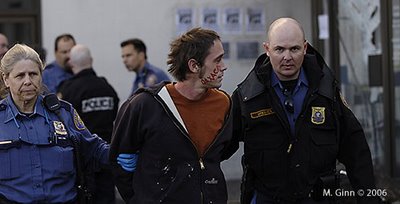 The laws in Portland are designed to make parking a bit of a hassle, to discourage driving. In my part of the city (NW) finding a spot to park can be particularly challenging, especially if you're looking for a spot that is not limited to two hours or less, which is the case for those of us who live here.
The laws in Portland are designed to make parking a bit of a hassle, to discourage driving. In my part of the city (NW) finding a spot to park can be particularly challenging, especially if you're looking for a spot that is not limited to two hours or less, which is the case for those of us who live here.
Walking around my neighbourhood, I've come to the conclusion that it is the barrio-of-choice for newcomers, though. Whenever I walk somewhere, I take an informal survey of the license plates I see parked on residential streets or non-commercial lots. The Oregon and Washington plates, and even California tags, are a gimme. But I find it surprising how many other out-of-state licences I can find right around my home. I found all 23 of the plates shown above within three blocks of my apartment, over the course of 15 minutes! I think I've seen all 50 states + D.C. at least once now.
I see many of them on a regular basis, so I know they live around here somewhere. However, since they don't have Oregon plates yet, I figure they must be fairly new to the area. (Surprisingly few from Canada, though. Either they change their plates quickly, or just don't move to this part of town!)
Since my last little game was so successful, I thought it was time for another. How many of the licence plates can you identify in the picture? (Click on the photo for a larger view.) Send me an email with your answers, and let me know if you're counting left to right or top to bottom. Yes, they are all from different states, and none are from Canada or Mexico.
Photo archive (partial)
Name that state! Wednesday, November 29, 2006
Posted by Matthew at 4:33 PM 0 comments
US Court of Appeals for the Ninth Circuit Tuesday, November 28, 2006
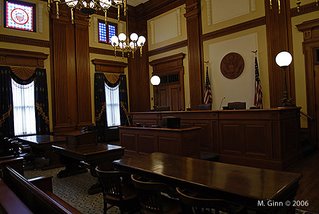 (right) The court room for the U.S. Court of Appeals for the Ninth Circuit in Portland, Ore., is in the historic Pioneer Courthouse.
(right) The court room for the U.S. Court of Appeals for the Ninth Circuit in Portland, Ore., is in the historic Pioneer Courthouse.
The U.S. Federal Court System, which handles cases involving federal laws and inter-state matters, is broken down into 94 court districts—at least one in every state, plus one in the District of Columbia, and Puerto Rico. There are also district courts in Guam, the U.S. Virgin Islands, and the Northern Mariana Islands.
The districts are organized into 11 circuits which hear appeals of those cases. Oregon, along with California, Washington, Idaho, Montana, Alaska and Hawaii, is part of the Ninth Circuit. (The District of Columbia and the Federal Circuit are not included in the 11 circuits.)
The Ninth Circuit has a reputation of being the most liberal in the country. Among its decisions was the determination that the words "under God" in the Pledge of Allegiance were unconstitutional, setting off a national uproar in 2002. (That decision came just after I moved to Nevada and just before the Fourth of July. The people at Elko's Independence Day celebrations made a point of shouting the "under God" part that year.)
With 28 judgeships, the Ninth is the largest circuit. It hears cases for about a week per month in Pasadena, San Francisco, and Seattle. Cases are heard in Portland for about a week every other month. They also hear cases in Anchorage and Honolulu a couple of times per year.
The court in Portland is in the historic Pioneer Courthouse, which I wrote about in a previous posting. The building was built between 1869 and 1875, and had a major expansion added in 1902-05. Approval was given to tear the building down in 1939 (to build a larger Federal Building), but the money was never appropriated for the construction. It also went a major seismic retrofit and restoration in 2002-05. The building is the oldest extant Federal Building in the Pacific Northwest. It was designated a National Historic Landmark in 1977.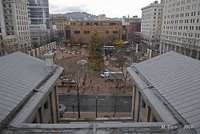 (left) The octagonal cupola atop Pioneer Courthouse gives a wonderful view of Pioneer Courthouse Square and other features of downtown Portland.
(left) The octagonal cupola atop Pioneer Courthouse gives a wonderful view of Pioneer Courthouse Square and other features of downtown Portland.
Posted by Matthew at 11:25 AM 0 comments
Tree lighting ceremony Sunday, November 26, 2006
 Thousands of people filled Pioneer Courthouse Square in downtown Portland on Nov. 24 for the lighting of the Stimson Lumber Tree. Stimson Lumber has committed to providing the City of Portland with a tree for the next four years.
Thousands of people filled Pioneer Courthouse Square in downtown Portland on Nov. 24 for the lighting of the Stimson Lumber Tree. Stimson Lumber has committed to providing the City of Portland with a tree for the next four years.The program for the tree lighting ceremony included a speech by Mayor Tom Potter, a Christmas singalong with a local area band, a musical appearance by Ed Robertson and Tyler Stewart of the Barenaked Ladies and, of course, Santa Claus.
Now that we're past Thanksgiving, the Christmas season is in full swing. Nov. 24 also included the Macy's Santa Claus Parade in downtown Portland.
Posted by Matthew at 9:39 AM 0 comments
Thanksgiving Saturday, November 25, 2006
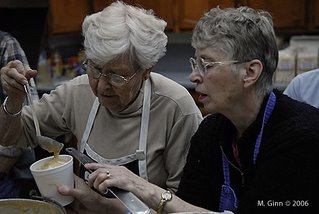 Sandy Montgomery holds a container of mashed potatoes as Evelyn Hedden adds gravy. The women, both from Pleasant Home United Methodist Church were helping prepare meals for the hungry at Rockwood United Methodist Church in Gresham on Thanksgiving day. Volunteers from six area churches served more than 170 free turkey dinners on Thursday afternoon.
Sandy Montgomery holds a container of mashed potatoes as Evelyn Hedden adds gravy. The women, both from Pleasant Home United Methodist Church were helping prepare meals for the hungry at Rockwood United Methodist Church in Gresham on Thanksgiving day. Volunteers from six area churches served more than 170 free turkey dinners on Thursday afternoon.
The Gresham Outlook assigned me to photograph a couple of "meals for the hungry" programs run by churches in Gresham on Thanksgiving Day. Immediately east of Portland, Gresham has a population of nearly 100,000 making it the largest suburb of the city. US Bank has a large data processing center in Gresham, and there is a large Boeing parts plant. There are also a few businesses in the high-tech sector. More people, however, commute to Portland.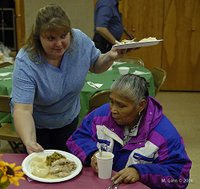 Kari Gustafson serves a turkey dinner to Juliavera Calisto of Gresham at Rockwood United Methodist Church on Thanksgiving day. Gustafson, who now lives in Vancouver, Wash., was volunteering with other members of Peace Church of the Brethren, which she used to attend.
Kari Gustafson serves a turkey dinner to Juliavera Calisto of Gresham at Rockwood United Methodist Church on Thanksgiving day. Gustafson, who now lives in Vancouver, Wash., was volunteering with other members of Peace Church of the Brethren, which she used to attend.
Posted by Matthew at 8:20 PM 0 comments
Babes and boobs Tuesday, November 21, 2006
This summary is not available. Please click here to view the post.
Posted by Matthew at 7:03 PM 3 comments
How to stage an effective protest
For today's protest du jour, we have the Oaxaca situation again. You may remember that I posted a couple of weeks ago about two protesters who had locked themselves to the door of the Mexican Consulate in Portland. Yesterday (Nov. 20) they were at it again. Except this time it wasn't anywhere near as dramatic. In fact, I have to say, that it was one of the least interesting protests I've had the chance to photograph. With that in mind, this posting presents a few tips for those would-be protesters for making their demonstration effective, at least from a photographic point of view.
Except this time it wasn't anywhere near as dramatic. In fact, I have to say, that it was one of the least interesting protests I've had the chance to photograph. With that in mind, this posting presents a few tips for those would-be protesters for making their demonstration effective, at least from a photographic point of view.
The point of most protests is to get a message across to the powers that be. Obviously, if you're protesting in front of, say, the Mexican Consulate, you want the people inside to know you're there. Maybe there were a dozen people inside. If you're lucky, they'll mention it in a report to their bosses at the embassy. And maybe a couple hundred people will walk by your event as you demonstrate, so you get them. But thousands will read the newspaper or watch the television news. If you can get those people onside, then your message has power. And the people inside the consulate will have a clipping they can send to their bosses at the embassy.
So what am I looking for in a news photo? As well as all of the technical and aesthetic elements that make a good picture, I need three things: a distinct group people (usually passionate), a message, and a target. And remember that most news stories only get one photograph, so I need all of those in one image.
Now, before anyone gets all uppity, remember that these are just the opinions of one photographer. I know that it's my job to make a storytelling image of whatever is thrown in front of me, regardless of the situation. I take pride in my ability to do that despite all the cards that are stacked against me. And I would never actually give suggestions to any subjects of a news photo—that would be unethical as I'm there to document what happens, not influence it. But these are some of the things that pass through my mind as I'm trying to capture a Pulitzer-prize winning image, or at least something that fairly represents the events I see. "Geez, I wish they would just ..." or "Aren't they going to do something?"
 Get the necessary permits. Yesterday's protest got off to a muted start because the group didn't have a permit to gather in Pioneer Courthouse Square. Yeah, I know they cost money, and you don't want to feed the system you're trying to fight against. But face it, like it or not, those guys are in charge. If you try to circumvent their rules, they'll shut you down right quick. That's not my problem; if it happens, I'll photograph that. But if you follow their rules and manage to beat them, it's an undeniable victory. At right, Sgt. Fender of the Portland Police Bureau explains the limits of what the group can do without a permit to one of the protest organizers.
Get the necessary permits. Yesterday's protest got off to a muted start because the group didn't have a permit to gather in Pioneer Courthouse Square. Yeah, I know they cost money, and you don't want to feed the system you're trying to fight against. But face it, like it or not, those guys are in charge. If you try to circumvent their rules, they'll shut you down right quick. That's not my problem; if it happens, I'll photograph that. But if you follow their rules and manage to beat them, it's an undeniable victory. At right, Sgt. Fender of the Portland Police Bureau explains the limits of what the group can do without a permit to one of the protest organizers.- Be organized. Admittedly, organizing anarchists is like herding cats. But protests aren't very effective when everybody is just standing around trying to come up with another chant to yell, or trying to figure out what route to take on the march.
- Get lots of people. Yes, you can make up for small numbers with enthusiasm, but that only goes so far. I don't care how passionate you are, systematic inhumane treatment of dust mites isn't newsworthy. One of the main criteria for whether something is newsworthy or not is whether people care. In a city of 1 million+, if you can only attract 30 people to your protest, that's an indication that your cause doesn't impact on that many people. I understand that a fire starts with a single spark. But a lot of sparks don't start fires at all. Call me when you've got a fire.
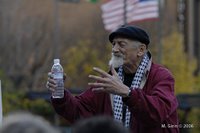 Most protests include a chance for group leaders to speak to the gathered crowd. I want to photograph their faces as they speak. But I also need something in the background that represents the cause, or what you are protesting. That would happen naturally if the speakers speak from the middle of the group, so that there are protesters and/or signs behind them. At least have a banner or something behind them. Otherwise, they just look like street corner preachers (see at right). Not newsworthy.
Most protests include a chance for group leaders to speak to the gathered crowd. I want to photograph their faces as they speak. But I also need something in the background that represents the cause, or what you are protesting. That would happen naturally if the speakers speak from the middle of the group, so that there are protesters and/or signs behind them. At least have a banner or something behind them. Otherwise, they just look like street corner preachers (see at right). Not newsworthy.- If you don't have lots of people, at least stick together. Unless it is symbolic of your cause, a thinly dispersed group of people "doesn't read well." That is, it's hard to convey the image of a group of people united for a cause. If everybody's wearing similar clothes or has the same hat or something, that also helps to visually unite the group.
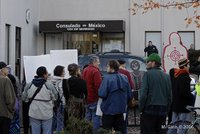 Have signs, lots of signs, and make them two-sided. Remember, photographs are visual things. For the most part, one group of people yelling and shaking their fists looks the same as another. So if you want your message to get across in print, you need some kind of recognizable symbol in the picture. I'm not suggesting that you should walk up to the photographer and show them your sign, but if you're there waving it about, you want to give the media a chance to capture it. Making two-sided signs helps. In the photo at right, for example, you can see a (thin) bunch of people in front of the Mexican Consulate in Portland. There's a cop in the background. They have signs, but most of them are facing the consulate. I understand that these people were picketing the consulate, and wanted to get a message to the people there. But if you have two-sided signs, then the people reading the paper will get your message too. Which is the more important audience—the dozen people inside who couldn't change anything if they wanted to, or the thousands who will read the newspaper? Why don't I just photograph the front of the people, you ask?
Have signs, lots of signs, and make them two-sided. Remember, photographs are visual things. For the most part, one group of people yelling and shaking their fists looks the same as another. So if you want your message to get across in print, you need some kind of recognizable symbol in the picture. I'm not suggesting that you should walk up to the photographer and show them your sign, but if you're there waving it about, you want to give the media a chance to capture it. Making two-sided signs helps. In the photo at right, for example, you can see a (thin) bunch of people in front of the Mexican Consulate in Portland. There's a cop in the background. They have signs, but most of them are facing the consulate. I understand that these people were picketing the consulate, and wanted to get a message to the people there. But if you have two-sided signs, then the people reading the paper will get your message too. Which is the more important audience—the dozen people inside who couldn't change anything if they wanted to, or the thousands who will read the newspaper? Why don't I just photograph the front of the people, you ask?  Three reasons: First, I need to get some kind of location in the picture, so people will know you're outside the Mexican Consulate, or at the Police Chief's house, or whatever your target is, and not just standing on the beach. Second, the police won't let me stand on private property any more than they allow the demonstrators to. Finally, I did, as best I could (see photo above).
Three reasons: First, I need to get some kind of location in the picture, so people will know you're outside the Mexican Consulate, or at the Police Chief's house, or whatever your target is, and not just standing on the beach. Second, the police won't let me stand on private property any more than they allow the demonstrators to. Finally, I did, as best I could (see photo above).- Use symbols that people know, and keep them simple and clear. Originality is great, but remember that the average reading time for a newspaper photograph is something less than a second. So it's got to be pretty obvious. If the reader (who probably doesn't know much about your cause) doesn't immediately understand the message, they will pass right by it. And if they don't read the picture, they won't read the story.
- Some of the most effective protests include some kind of performance that symbolizes your message. Acting out something or setting up a dramatic tableau that represents your cause makes for a good photo op. I don't want to suggest pulling any stunts that would get you arrested but, frankly, that had a lot to do with why the last Oaxaca protest made the news and yesterday's didn't.
Posted by Matthew at 6:25 PM 0 comments
Labels: protest
Working on the Tree Monday, November 20, 2006
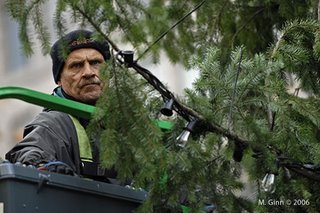 Workers are as busy as beavers putting thousands of lights on the 2006 Tree for Portland, donated by Stimson Lumber.
Workers are as busy as beavers putting thousands of lights on the 2006 Tree for Portland, donated by Stimson Lumber.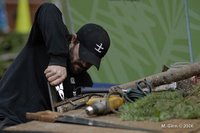 (right) A Pioneer Courthouse Square employee mounts a bracket on one of the branches so that it can be reattached to the tree. Most of the branches were removed from the tree for transport. The tree will be fully reassembled and decorated with lights in time for Friday's lighting ceremony.
(right) A Pioneer Courthouse Square employee mounts a bracket on one of the branches so that it can be reattached to the tree. Most of the branches were removed from the tree for transport. The tree will be fully reassembled and decorated with lights in time for Friday's lighting ceremony.
Posted by Matthew at 5:34 PM 0 comments
Gales Creek Camp Sunday, November 19, 2006
About 21 million Americans have diabetes. Maddie Ehl developed Type 1 diabetes at the age of three. Now 9 years old, Maddie is the inspiration for one of the largest teams in the Summit to Surf ride. (The ride is a part of the nationwide Tour de Cure, organized by the American Diabetes Association to raise money for diabetes research.) Maddie's Riders raised so much money—nearly $16,000 last year—that they won a $1,100 indoor cycling bike.
But rather than share the bike among the 60 team members, they donated it to the charity auction for Gales Creek Camp. Gales Creek, about 30 miles west of Portland, runs summer camps for children, teens and families affected by diabetes.
My friend Stacey volunteers with a number of different organizations. She came to Portland more recently than I did, but she's already connected with the camp. On Saturday night, they held a spaghetti dinner and auction to raise money for the camp, and she asked me to help with it. We sold raffle tickets for $1 each, and raised several hundred dollars. Together with the dinner and auction, the event raised several thousand dollars for the camp.
[Sorry, no pictures for this post. I didn't bring my camera with me. Maybe something tomorrow ...]
Posted by Matthew at 9:16 PM 0 comments
70-foot tree sprouts overnight in downtown Portland! Monday, November 13, 2006
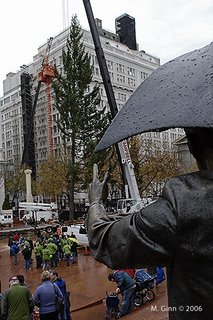 J. Seward Johnson's statue "Allow Me" seems to point at the Stimson Lumber Tree as it is unloaded at Pioneer Courthouse Square on Nov. 13. The 70-foot Douglas fir was cut in Gaston on Friday. The lighting ceremony is Nov. 24 at 5:30 p.m.
J. Seward Johnson's statue "Allow Me" seems to point at the Stimson Lumber Tree as it is unloaded at Pioneer Courthouse Square on Nov. 13. The 70-foot Douglas fir was cut in Gaston on Friday. The lighting ceremony is Nov. 24 at 5:30 p.m.Every winter, Stimson Lumber donates a tree to the City of Portland to place in Pioneer Courthouse Square. It arrived in a short parade with a band and police escort, as well as a marketing team from Cricket cell phone service, one of the major sponsors.
The main thing people should know, says Pioneer Courthouse Square employee Mahlin Shisler, "is what an awesome gift it is from Stimson to the City of Portland." Many other companies also contributed, he added, including Campbell Crane and Sunbelt Rentals.
It's more difficult finding a good tree for downtown Portland than for yourself. "At home," says Bill Akers of Portland Parks and Recreation, "you only have to look at one or two sides. Here, you see all four."
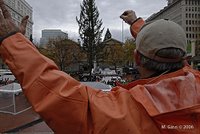 (left) Bill Akers uses a plumb line to help fellow Portland Parks and Recreation employees align the Stimson Lumber Tree at Pioneer Courthouse Square on Nov. 13.
(left) Bill Akers uses a plumb line to help fellow Portland Parks and Recreation employees align the Stimson Lumber Tree at Pioneer Courthouse Square on Nov. 13. What should you look for in a tree? "Straight as possible ... nice shape, nice top," says Shisler. They also have to make sure the branches aren't too brittle, so it can make it beneath the overpasses on its way to the square.
Most of the branches are cut off to transport the tree. They came in a second truck, and will be reattached this afternoon. Then city crews will put thousands of lights on the tree in time for the lighting ceremony on Nov. 24.
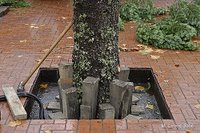 (right) The tree sits in a specially-designed hole in the middle of the square, supported by giant shims. Workers will construct a 5-foot tall "bucket" around the base.
(right) The tree sits in a specially-designed hole in the middle of the square, supported by giant shims. Workers will construct a 5-foot tall "bucket" around the base.Posted by Matthew at 2:49 PM 0 comments
What in the World? (Answer)

Regular readers will remember that I posted a small detail of a photo last week, asking you to guess what was pictured. Here is the answer—purple cauliflower. I found it on sale at the Portland Farmers Market. Thanks to everyone who participated. The winner, randomly selected from the correct entries, was ... oh, wait, we didn't have any entries. Too bad, the prize was a Ferrari. I guess I'll have to keep it. Better luck next time.
Posted by Matthew at 7:54 AM 0 comments
Labels: what in the world?
One more thing ... Sunday, November 12, 2006
 Santa Claus (aka Dick Ellis, a Navy Vietnam Veteran) salutes the crowd at the Veterans Day ceremonies on Nov. 11. But he wasn't there to give out toys—he was collecting toys for needy children.
Santa Claus (aka Dick Ellis, a Navy Vietnam Veteran) salutes the crowd at the Veterans Day ceremonies on Nov. 11. But he wasn't there to give out toys—he was collecting toys for needy children.
Posted by Matthew at 2:14 PM 0 comments
It's Veterans Day, remember? Saturday, November 11, 2006
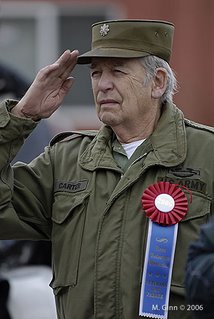 Russell Carter salutes as the flag is raised at precisely 11 o'clock during Veterans Day ceremonies in Portland, Ore. Carter served in the European theater in World War II.
Russell Carter salutes as the flag is raised at precisely 11 o'clock during Veterans Day ceremonies in Portland, Ore. Carter served in the European theater in World War II.
In Flanders fields the poppies blow/Between the crosses row on row/That mark our place ...
When I was growing up, November 11 always seemed to be a big deal. At the beginning of November, white boxes full of little plastic poppies appear in the stores, and people would bring them around to our classes. For a donation of a few cents, you too could pin a red flower with a green center to your jacket just like all the grownups. Or you could fold them in half, stick them between your lips and pretend you were wearing lipstick, which is what we usually did. Even if you decided to wear it, they kept falling off your jacket, so you had to make another donation every few days.
The first few years I was in school, Remembrance Day (as it is known in Canada) was a holiday. Later, they kept us in school so that we could learn more about the meaning of the date, which invariably meant assemblies, and poetry/essay/poster contests. I never won.
... and in the sky/the larks still bravely singing, fly/Scarce heard amid the guns below.
I was a Beaver/Cub/Scout throughout my childhood, so on the Saturday nearest Nov. 11 we got to be in the parade. As well as the Scouts and Guides, there was the Acton Citizens Band, the high school band, a pipe band, the air cadets, and as many legionnaires as figured they could make the walk through town on a snowy November day. The parade always ended at the local cenotaph where someone would read off the names, they'd play Taps, and we'd have a minute of silence to remember the dead. I didn't know anyone who had died in any wars, so I'd try to figure out what I was supposed to think about, and make sure I didn't cough, sneeze, or giggle when someone else did. Eventually they would play Reveille and we could breathe again. Once they had played Abide With Me, it was time to go home.
We are the dead. Short days ago/We lived, felt dawn, saw sunset glow,/Loved and were loved and now we lie/In Flanders fields.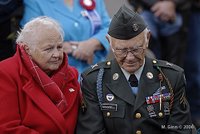 Beside his wife, Beatrice, Robert D. Maxwell bows his head as his citation for bravery is read during Veterans Day ceremonies in Portland, Ore. On Sept. 7, 1944, Maxwell threw himself on a grenade as he and three other soldiers defended their observation post against a full platoon of enemy soldiers. Maxwell was permanently injured by the explosion, but his action saved the lives of his comrades and earned him the Medal of Honor. He is the only Medal of Honor recipient living in Oregon.
Beside his wife, Beatrice, Robert D. Maxwell bows his head as his citation for bravery is read during Veterans Day ceremonies in Portland, Ore. On Sept. 7, 1944, Maxwell threw himself on a grenade as he and three other soldiers defended their observation post against a full platoon of enemy soldiers. Maxwell was permanently injured by the explosion, but his action saved the lives of his comrades and earned him the Medal of Honor. He is the only Medal of Honor recipient living in Oregon.
I think this was the first Veterans Day ceremony I've attended since I moved to the United States. In Portland, it was marked with a small parade and an hour-long ceremony in the Hollywood district. It wasn't really that different than the ceremonies I grew up with. A piper played Amazing Grace; a trio sang God Bless America and America the Beautiful; the Grant High School band played the Star Spangled Banner as the flag was raised; and the Legion Honor Guard fired a 12-gun salute. (You couldn't see the Air Force jets that made a fly-by right at 11 o'clock due to the mostly-cloudy skies, but there weren't too many complaints; most people were happy that it wasn't raining.)
Because I was busy photographing the event, I wasn't thinking too much about its content. But when they started reading John McRae's "In Flanders Fields," I was suddenly taken back to Acton as I mouthed the words that every Canadian schoolchild learns.
Take up our quarrel with the foe:/To you from failing hands we throw/The torch; be yours to hold it high ...
It wasn't until I got home that I realized how much I missed the moment of silence that I've always associated with November 11, and remembered the words at the bottom of every cenotaph: "Lest we forget." It's probably something that goes better with Memorial Day here. Still, perhaps we would do well to repeat it twice a year. That induction is meant to remind us of the sacrifice that those men and women made on our behalf.
If ye break faith with us who die/We shall not sleep, though poppies grow/In Flanders fields.
What, though, of the sacrifice that our families and nations made in sending generations of young men (and now, young women) to fight. Even those who come back with all of their body parts intact are mentally and emotionally scarred. In a day where the threats and enemies are becoming more and more impalpable, one can't help wonder whether the incredible levels of resources--physical, financial, and organizational--dedicated to fighting them couldn't be better applied elsewhere.
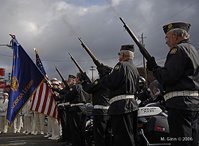 The American Legion Honor Guard fires off a round in salute during Veterans Day ceremonies in Portland, Ore.
The American Legion Honor Guard fires off a round in salute during Veterans Day ceremonies in Portland, Ore.One of the biggest differences I have noticed, living in the United States instead of Canada, is that in this country, it seems like everyone has served in the armed forces. In Canada, I knew only a handful of people in the reserves, none of whom had seen active duty in a war zone. Here, every family is directly connected to someone who is or was in the military. If they didn't themself serve, their brother, sister, spouse or children did. I've never been in combat--and never wish to be--but by all accounts it's a horrible experience. It's a huge sacrifice to make.
As Americans and Canadians, we enjoy a wonderful standard of living and a huge degree of freedom in our lives. There is no doubt that that freedom is worth defending. And no one doubts the courage or skill of the soldiers charged with doing so. It seems to me, though, that the "threats" we face today (e.g. Iraq, Iran, North Korea, and even al Qaeda) are caused more by people that feel threatened by us rather than people who want to make us subservient to them (as was the case through the Cold War). But what was our response? To threaten them more explicitly--"We're going to come to your country and impose our system of government so you can see how much better it is. And you will thank us for it. Or else."
Does it not make more sense to wait for other people to ask us for advice or assistance, rather than unilaterally telling them how we're going to make their lives better? Freedom on the march, indeed.
They say that those who forget the past are doomed to repeat it. Both Canada and the United States have made huge sacrifices in the theater of war in the past. Perhaps we need to take another minute of silence to think about that. Lest we forget.
Posted by Matthew at 3:02 PM 2 comments
Election Day Tuesday, November 07, 2006
 A voter drops off her ballot at Pioneer Courthouse Square in downtown Portland, Ore., on Tuesday. There are no polling stations in Oregon. Instead, voters cast their ballots by mail or by dropping them off at official sites around the state.
A voter drops off her ballot at Pioneer Courthouse Square in downtown Portland, Ore., on Tuesday. There are no polling stations in Oregon. Instead, voters cast their ballots by mail or by dropping them off at official sites around the state.
The first Tuesday in November is Election Day in the United States. Unlike elections in Canada, where the voting process is essentially uniform from coast to coast, the rules and mechanisms for voting in the United States vary widely from state to state. And, with the controversies of the last two elections, many states have changed the procedures for this election. Some states have implemented computerized voting machines, others have changed the rules for what kinds of ID voters must present. Voters who are denied ballots are allowed to complete provisional ballots, which are counted if the voters eligibility is proven.
Since 1998, voting in Oregon has been conducted by mail. Voting kits are mailed to every registered voter. Once completed, the ballots are sealed inside a secrecy envelope, which in turn is sealed inside the mailing envelope. The voter signs the outer envelope and drops it in the mail or at an official drop site (no postage necessary that way).
Posted by Matthew at 4:38 PM 0 comments
What in the World? Monday, November 06, 2006
 When I was a kid, I had a subscription to National Geographic's World magazine, which always included a feature called "What in the World?" where the reader tried to figure out what was depicted in a close-up photograph of something. Today we are playing the same game.
When I was a kid, I had a subscription to National Geographic's World magazine, which always included a feature called "What in the World?" where the reader tried to figure out what was depicted in a close-up photograph of something. Today we are playing the same game.
Can you figure out what is pictured above? Note that the photo is not digitally manipulated or coloured. I'm led to believe that the subject naturally appears this way. Feel free to leave your guesses in the comments or, if you don't want to give hints to the other readers, you can email them to me. I'll publish the answer (with the full photo) next week.
Posted by Matthew at 9:51 AM 0 comments
Labels: what in the world?
Rainy day in the Pearl Friday, November 03, 2006
 Rain, rain/wind, light rain, rain, showers, few showers, mostly cloudy, showers, showers, showers. That's the forecast for Portland weather over the next ten days.
Rain, rain/wind, light rain, rain, showers, few showers, mostly cloudy, showers, showers, showers. That's the forecast for Portland weather over the next ten days.
Portland doesn't really have four seasons, just two: wet and dry. Sure, there's some transition time between the two when it can be either wet or dry, but there is no real "spring" or "fall." Setting the clocks back to standard time seems to mark the return of the rains.
The Pearl District, in NW Portland between about NW 9th Ave. and I-405, is a rapidly developing part of town. What used to be an old warehouse district just 10 or 15 years ago is now filled with trendy restaurants, hip art galleries, tony loft apartments and chic condominiums. It's the kind of place that young lawyers, architects, and dot-com executives live. I don't. But it is within walking distance, so I can take advantage of its amenities when I please.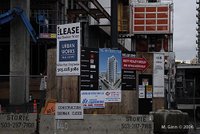 Developers are building condomium towers in Portland's Pearl District at an incredible pace. Some people have expressed concern that the area is not family-friendly. But isn't that what the suburbs are for?
Developers are building condomium towers in Portland's Pearl District at an incredible pace. Some people have expressed concern that the area is not family-friendly. But isn't that what the suburbs are for?
[ed's note: You may notice that I've caught up to the present with my postings. Unfortunately that means that updates won't be quite as frequent in the future. But rest assured, as new material is available, I will post it.]
Posted by Matthew at 11:46 AM 0 comments
October 31 Thursday, November 02, 2006
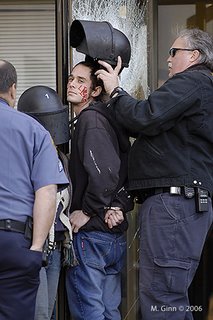 A protective helmet is put on Mateo Bernal's head as he and Nikki Thanos stand locked to the door of the Mexican Consulate in Portland, Ore., on Oct. 31, 2006. They were protesting the police action in Oaxaca, Mexico. Police arrested the pair and cut the bicycle locks off their necks.
A protective helmet is put on Mateo Bernal's head as he and Nikki Thanos stand locked to the door of the Mexican Consulate in Portland, Ore., on Oct. 31, 2006. They were protesting the police action in Oaxaca, Mexico. Police arrested the pair and cut the bicycle locks off their necks.
Another posting, another demonstration? Seems that way these days.
There has been unrest in Oaxaca, Mexico, since at least June when protestors forced local and state police out of the city. Since then, at least a dozen people have been killed, including an American activist/journalist. Outgoing President Vicente Fox has promised to resolve the situation before his successor takes over on Dec. 1.
The violence increased last weekend when three people were shot. Fox sent in federal police to control the situation, but the level of violence has not decreased. Police had taken control of the city yesterday, but just today (Nov. 2) the protestors appear to have forced them back again. Activists in Portland have been supporting those in Oaxaca by protesting outside the Mexican Consulate. There was a demonstration planned for Oct. 31 at 4 p.m., but two protestors got things started a bit early when they locked themselves to the door of the consulate around 2 o'clock. Of course, they were arrested and charged with mischief, but they did attract media attention which, presumably, was the goal. I didn't stick around for the planned protest. Apparently there were around 70 demonstrators.
Activists in Portland have been supporting those in Oaxaca by protesting outside the Mexican Consulate. There was a demonstration planned for Oct. 31 at 4 p.m., but two protestors got things started a bit early when they locked themselves to the door of the consulate around 2 o'clock. Of course, they were arrested and charged with mischief, but they did attract media attention which, presumably, was the goal. I didn't stick around for the planned protest. Apparently there were around 70 demonstrators.
Posted by Matthew at 6:08 PM 0 comments
October 22

Protestors demonstrate in Pioneer Courthouse Square on Oct. 22. The group of about 30 marched there from the North Park Blocks carrying signs that read "Cops and Klan, Hand in Hand" and "Stop killing us," in reference to people who have died in police custody in Portland. After demonstrating downtown, the group headed to the West Hills to demonstrate outside Police Chief Rosie Sizer's house.
As I mentioned in my previous post, the police have been in the news a lot recently. But it's not all about racial tensions. Several people have died in police custody in the Portland Metro area in the past few years. A group called Portland Copwatch has compiled a list of police shootings and other deaths, including five so far this year.
After posing for photographs and shouting slogans for a few minutes in Pioneer Courthouse Square, and milling about trying to figure out what to do next, the group split up and went to a few downtown bus stops. There, they all boarded the same bus and headed out to the West Hills to demonstrate outside Chief Sizer's house. The police arrived there just before the protestors, and kept them on the roadway (but not blocking traffic). After about twenty minutes of shouting more slogans, the protestors split up. I learned later that they returned to downtown to protest another location. I stayed at Chief Sizer's house with the police and a Fox TV reporter. A few minutes later, the chief and her husband (a retired police officer) stepped outside to talk with the police guarding her home. Shortly thereafter, most of the police left and so did I.
I stayed at Chief Sizer's house with the police and a Fox TV reporter. A few minutes later, the chief and her husband (a retired police officer) stepped outside to talk with the police guarding her home. Shortly thereafter, most of the police left and so did I.
(below) Protestors ride the bus to protest at Portland Police Chief Rosie Sizer's home in the West Hills.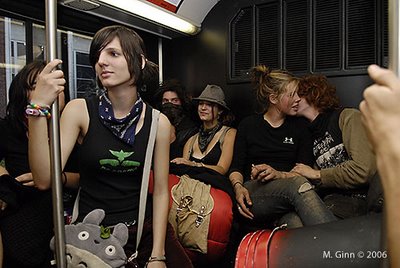
Posted by Matthew at 9:36 AM 0 comments
October 19 Wednesday, November 01, 2006
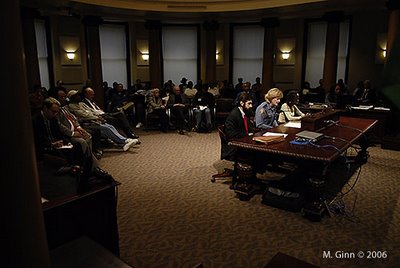 Police Chief Rosie Sizer speaks before Portland City Council on Oct. 19, 2006. The Police Bureau, Oregon Action, and Northwest Constitutional Rights Center presented a report on racial profiling to the council.
Police Chief Rosie Sizer speaks before Portland City Council on Oct. 19, 2006. The Police Bureau, Oregon Action, and Northwest Constitutional Rights Center presented a report on racial profiling to the council.As in so many American cities (and probably most large Canadian cities), inter-racial relations are regularly in the news in Portland. Yes, I said Portland, even though it is one of the whitest large cities in the United States. These days, it usually seems to involve the police. Sometimes the tensions are between the police and the public, othertimes within the bureau.
Portland's police chief used to be a black man named Derrick Foxworth. He was demoted this spring by Mayor Tom Potter (a white man, himself a former police chief) after Angela Oswalt, a white desk clerk in the bureau, filed a law suit and released numerous explicit emails sent to her by Foxworth while they were having an affair (years before he became chief). The investigation by the city cleared Foxworth on all but one relatively minor charge. Nevertheless, the mayor "concluded that Chief Foxworth's ability to lead the organization effectively as chief has been damaged."
Now, Foxworth is suing the city, claiming that the real reason for his demotion was that he is African-American and had a relationship with a caucasian woman.
During Foxworth's tenure as police chief, a process was started in an attempt to improve relations between the police bureau and the African-American community in Portland. This was not the first attempt by any means, but its supporters are optimistic that this process will initiate real changes. The effort was a collaboration between the Police Bureau and several community groups. They met in a number of "community listening sessions," looked at police bureau statistics, discussed, and made several recommendations. The report was presented to city council on Oct. 19.
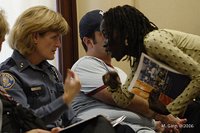 Portland Police Chief Rosie Sizer (left) and Jo Ann Bowman of Oregan Action talk before presenting a report on racial profiling to Portland City Council.
Portland Police Chief Rosie Sizer (left) and Jo Ann Bowman of Oregan Action talk before presenting a report on racial profiling to Portland City Council.Posted by Matthew at 2:36 PM 0 comments
October 13
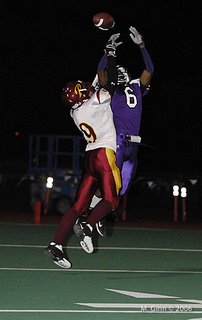 (both pictures) Heritage High's Hakeim Pearson (right) tips the ball away from intended receiver Zach Erwin in the first quarter of the game against Prairie High School on Oct. 13, 2006. Prairie won the game 14-12.
(both pictures) Heritage High's Hakeim Pearson (right) tips the ball away from intended receiver Zach Erwin in the first quarter of the game against Prairie High School on Oct. 13, 2006. Prairie won the game 14-12.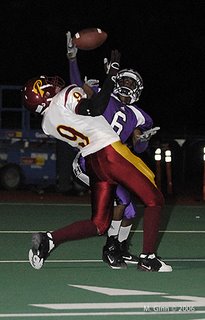 These two frames, taken less than a second apart, were made at a football game in Vancouver, Wash., on October 13. Which picture do you run? (You can click on the photos for a larger view.) The first captures the peak of the action, but the defender (no. 6) has arms blocking most of his face. You see his face in the second photo, but the moment has pretty much gone by.
These two frames, taken less than a second apart, were made at a football game in Vancouver, Wash., on October 13. Which picture do you run? (You can click on the photos for a larger view.) The first captures the peak of the action, but the defender (no. 6) has arms blocking most of his face. You see his face in the second photo, but the moment has pretty much gone by.
Posted by Matthew at 7:43 AM 0 comments
Labels: sports

